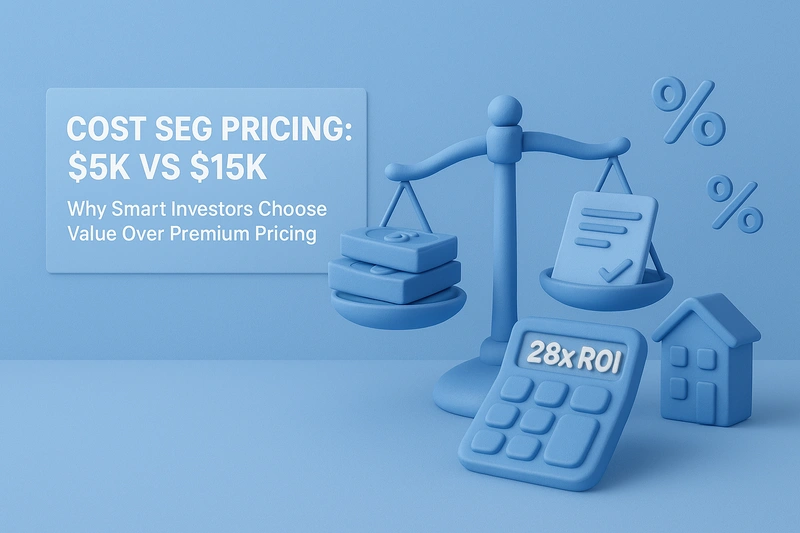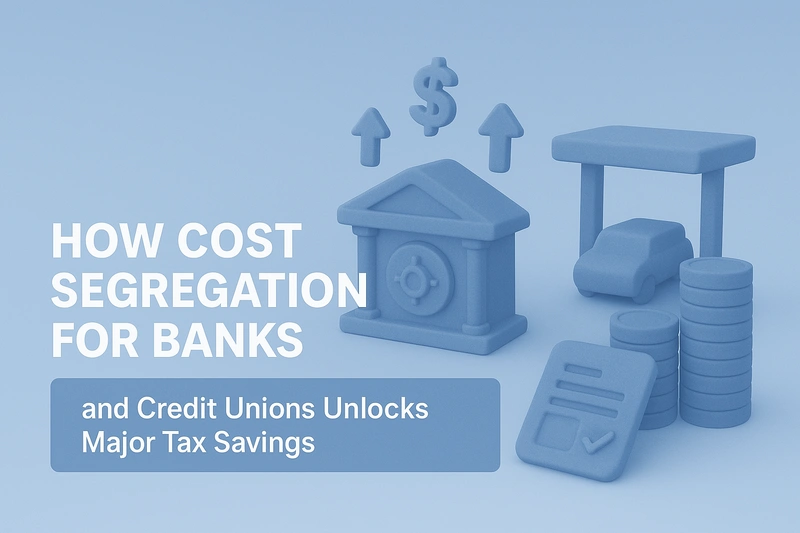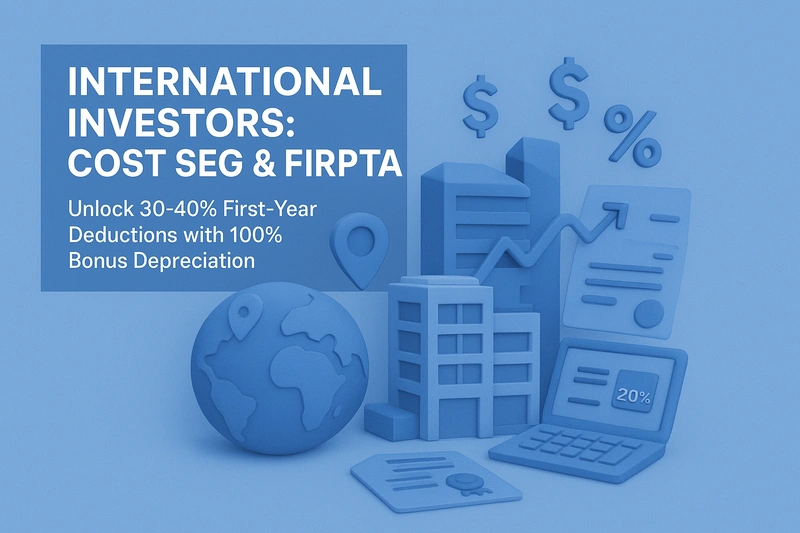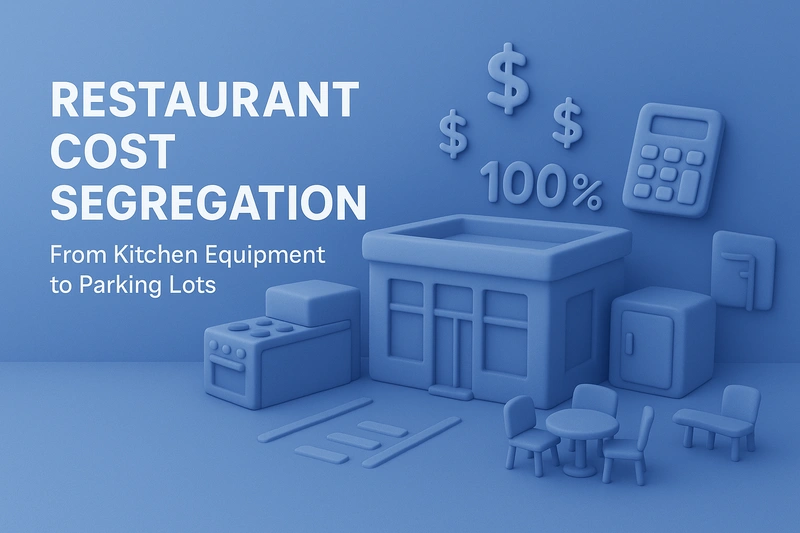As of January 20, 2025, the Big Beautiful Bill has permanently restored 100% bonus depreciation. This legislative update fundamentally changes the cost segregation landscape for real estate investors. Properties placed in service today can immediately write off qualifying components identified through cost segregation studies.
This permanent restoration creates an unprecedented opportunity. Investors can now confidently plan long-term tax strategies knowing that accelerated depreciation benefits won't phase out. Every dollar of personal property and land improvements identified through cost segregation qualifies for immediate expensing.
Yet a critical question emerges: Why pay $15,000 or more for cost segregation services when R.E. Cost Seg and other efficient providers deliver IRS-compliant studies for $5,000?
The pricing disparity in the cost segregation industry has reached extreme levels. Some firms charge $25,000 for studies on properties that identical analysis elsewhere costs one-fifth that amount. These inflated fees directly reduce your investment returns without providing additional tax benefits or audit protection.
Smart investors recognize a fundamental truth: Cost segregation pricing should reflect the actual work performed, not brand prestige. The IRS evaluates studies based on methodology and documentation quality. They don't award bonus points for expensive reports.
This analysis examines why affordable cost segregation services consistently outperform premium-priced alternatives on the metrics that matter: tax savings, ROI, and IRS compliance. We'll demonstrate how choosing value-focused providers preserves more capital for property acquisition while achieving identical depreciation benefits.
The Cost Segregation Pricing Landscape
Current cost segregation pricing ranges from $2,800 to $25,000 and beyond. This vast disparity reflects market inefficiencies rather than service quality differences. R.E. Cost Seg routinely encounters investors who previously paid premium prices for studies that delivered no additional value beyond our standard offerings.
Several factors legitimately affect the cost seg study cost. Property size directly impacts the analysis scope. A 200-unit apartment complex requires more detailed component analysis than a single-family rental. Commercial properties with specialized systems demand additional engineering expertise. Multi-state portfolios need jurisdictional tax considerations.
Documentation availability also influences pricing. Properties with complete construction records enable faster, more accurate studies. Conversely, older buildings requiring extensive estimation work may warrant modest fee adjustments. Geographic factors play a minor role, primarily affecting site visit logistics when physical inspections prove necessary.
The Truth About Fee Structures
The IRS Audit Technique Guide specifically warns about contingency fee arrangements. These fee structures, where providers charge based on tax savings achieved, create incentives to inflate personal property classifications. The IRS directs examiners to scrutinize contingency-based studies more carefully, citing potential Circular 230 violations.
Most reputable firms use fixed-fee pricing based on property characteristics. This approach aligns provider and client interests while maintaining objectivity. R.E. Cost Seg employs transparent, upfront pricing that reflects actual work performed.
Size-based pricing models often disconnect from reality. A $5 million property doesn't automatically require three times the analysis effort of a $1.5 million property. Smart investors question why identical property types generate wildly different quotes simply because one sits in Manhattan versus Memphis.
What determines the cost of a cost segregation study?
Property complexity drives legitimate pricing differences. Standard residential properties typically range from $2,800 to $5,000. Manufacturing facilities or medical buildings with specialized equipment may justify higher fees. Premium pricing without corresponding complexity signals provider inefficiency.
Why Premium Pricing Doesn't Equal Premium Quality
The IRS Audit Technique Guide establishes 13 principal elements that define quality cost segregation studies. These requirements focus exclusively on methodology, documentation, and technical accuracy. Price never enters the equation.
Quality studies must classify assets into proper categories with clear rationale for IRC Section 1245 versus Section 1250 designations. They require detailed methodology descriptions and appropriate documentation supporting cost allocations. The preparer needs demonstrated expertise in construction and engineering, not marketing prowess.
Critical elements include interviews with appropriate parties, use of common nomenclature, and consideration of related issues like land value allocation. The study must substantiate each asset's cost basis and reconcile total allocated costs to actual expenditures. These technical requirements remain identical whether the study costs $5,000 or $50,000.
The IRS explicitly states it has not established fee requirements or standards. Examiners evaluate studies based on engineering approaches and documentation quality. When reviewing cost segregation during audits, IRS engineers examine methodology accuracy, not invoice amounts.
Debunking the Premium Price Myth
Recent property comparisons reveal striking patterns. Two identical 150-unit apartment complexes in similar markets generated vastly different quotes. One national firm proposed $18,000, emphasizing their "comprehensive process." R.E. Cost Seg completed an equally thorough study for $5,500.
Both studies employed detailed engineering approaches. Both properly classified components per IRS guidelines. Both identified nearly identical personal property percentages. The tax savings achieved matched within 2%. The only meaningful difference: the investor using R.E. Cost Seg retained $12,500 more capital.
This pattern repeats across property types. Office buildings, retail centers, and industrial facilities show similar pricing disparities without corresponding quality differences. Premium providers cannot demonstrate superior audit protection, enhanced tax savings, or better documentation. They simply charge more.
The Overhead Factor
Large firms maintain extensive overhead structures. Downtown office towers, multi-layer management, national advertising campaigns, and large sales teams all require funding. These costs flow directly to client invoices without improving study quality.
Technology has fundamentally changed cost segregation economics. Advanced software accelerates calculations and report generation. Digital documentation eliminates physical file management. Virtual site visits often replace costly travel. R.E. Cost Seg leverages these efficiencies to reduce costs while maintaining quality.
Specialized providers operate with focused efficiency. Without bloated infrastructure, they deliver superior value propositions. Every dollar saved on unnecessary overhead returns to investors for property acquisition or improvement.
Will a cheaper cost segregation study survive an IRS audit?
IRS audit survival depends entirely on methodology and documentation quality. The Service examines whether studies properly apply tax law and engineering principles. Well-documented $5,000 studies from qualified providers face no additional audit risk compared to overpriced alternatives. The 13 quality elements established by the IRS make no reference to fee levels.
The Smart Investor's Value Analysis of Cost Segregation
Real estate investors understand one fundamental metric: return on investment. Cost segregation ROI calculations reveal why affordable providers deliver superior value. Consider this detailed analysis for a typical $2 million apartment building.
Property basis after land value: $1,500,000. A properly executed cost segregation study identifies approximately $400,000 in 5-year and 15-year assets. With permanent 100% bonus depreciation now restored through the Big Beautiful Bill, this entire amount becomes immediately deductible.
For investors with real estate professional status taxed at 35%, this generates $140,000 in Year One tax savings. The math becomes compelling when comparing provider options:
R.E. Cost Seg at $5,000: Returns 28x investment
Premium provider at $15,000: Returns 9.3x investment
Difference: $10,000 additional capital preserved
This $10,000 difference represents pure opportunity cost. Smart investors recognize that overpaying for identical tax benefits reduces portfolio growth potential. The saved capital could fund additional property analysis, contribute to down payments, or accelerate renovation projects.
The Opportunity Cost of Overpaying
Every dollar wasted on inflated cost segregation fees represents lost investment potential. That $10,000 premium paid unnecessarily could serve as earnest money on another property. Compounded over multiple acquisitions, these savings become substantial.
Consider an active investor analyzing four properties annually. Choosing affordable cost segregation services saves $40,000 per year. Over five years, that's $200,000 in preserved capital, enough for down payments on additional income-producing assets.
The mathematics of reinvestment amplify these benefits. Capital deployed into property acquisition generates rental income, appreciation, and additional depreciation benefits. Money spent on overpriced studies generates nothing beyond what affordable alternatives already provide.
Speed and Efficiency Benefits
Time represents another critical value component. R.E. Cost Seg typically delivers comprehensive studies within 2-3 weeks. Many premium providers quote 6-8 week turnaround times. This delay costs investors valuable depreciation deductions and complicates Form 3115 filing when changing accounting methods.
Streamlined processes eliminate unnecessary delays. Digital documentation review, efficient engineering analysis, and focused report generation accelerate delivery without sacrificing quality. Faster implementation means quicker realization of tax benefits, improving cash flow when investors need it most.
Efficiency extends beyond speed. Standardized procedures reduce back-and-forth communications. Clear, concise reports eliminate confusion. Direct access to engineering professionals resolves questions quickly. These operational advantages translate directly to investor value.
How much should I expect to pay for a cost seg study on my property?
Residential rental properties under $5 million typically warrant fees between $3,000 and $6,000. Commercial properties range from $5,000 to $10,00, depending on complexity. Industrial facilities with specialized equipment may justify slightly higher fees. Any quote exceeding these ranges demands exceptional justification based on unique property characteristics.
What Actually Matters in Cost Segregation
Five critical elements determine cost segregation study quality, regardless of provider or price point.
Engineering-based methodology forms the foundation. The IRS recognizes detailed engineering approaches using actual costs or proper estimation techniques. Studies must systematically analyze building components, not rely on arbitrary percentages or industry averages.
A detailed component breakdown with proper classification distinguishes legitimate studies from inadequate attempts. Each asset requires individual analysis, determining whether it qualifies as Section 1245 personal property or remains Section 1250 real property.
Clear documentation meeting IRS standards cannot be compromised. This includes construction drawings, specifications, contractor invoices, and detailed cost allocations. Quality studies provide transparent audit trails linking every classification decision to supporting evidence.
Qualified professionals with demonstrated construction and engineering backgrounds must prepare studies. Tax law knowledge alone proves insufficient. The complexity of modern construction demands technical expertise to properly identify and value components.
Defensible asset classifications supported by legal citations complete the requirements. Each reclassification needs grounding in relevant court cases, revenue rulings, and IRS guidance. Aggressive positions without proper support invite audit challenges.
What Doesn't Matter
Several factors commonly associated with premium pricing add no actual value to cost segregation studies.
Firm size provides no quality guarantee. Large national companies and boutique specialists produce equally valid studies when following proper methodology. Brand recognition doesn't improve IRS compliance.
Physical site visits, while sometimes beneficial, prove unnecessary for standard properties with complete documentation. Virtual inspections using photographs and video often suffice, particularly for conventional apartment buildings or office spaces.
Excessive report length signals inefficiency, not thoroughness. Concise, well-organized studies communicate findings more effectively than verbose documents padded with redundant information.
Your Cost Segregation Checklist
Take these concrete steps to maximize value from cost segregation services:
Request detailed quotes from multiple providers, including R.E. Cost Seg. Compare not just prices but turnaround times and included services.
Demand sample reports demonstrating methodology and documentation standards. Quality providers willingly share redacted examples.
Verify engineering credentials and experience. Ask specifically about similar property types analyzed.
Calculate your specific ROI using current tax rates and bonus depreciation benefits. Factor in state tax savings where applicable.
Choose providers based on value delivered, not marketing materials. Remember that IRS compliance depends on methodology, not fee levels.
Consider reinvesting fee savings into additional properties or improvements. Every dollar saved expands investment capacity.
Maximize Your 100% Bonus Depreciation Opportunity
The permanent restoration of 100% bonus depreciation through the Big Beautiful Bill creates unprecedented tax savings opportunities. Cost segregation unlocks these benefits by properly classifying building components for accelerated depreciation.
Provider selection significantly impacts investment returns. Paying $15,000 for studies that R.E. Cost Seg completes for $5,000 wastes capital without improving tax benefits or audit protection. The IRS evaluates studies based on technical merit, not invoice amounts.
Smart investors recognize that affordable cost segregation services deliver identical IRS-compliant results while preserving capital for growth. Choose value over vanity pricing. Your portfolio expansion depends on maximizing every dollar's potential.
Ready to see how much you could save with a cost segregation study? Calculate your potential tax savings and ROI with our free proposal and discover why smart investors choose R.E. Cost Seg's value-focused approach over overpriced alternatives.






